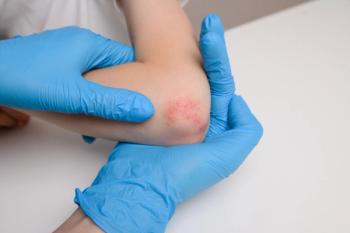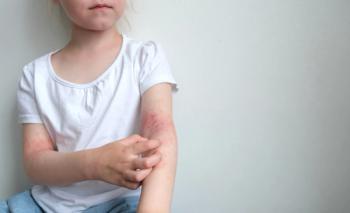
Dupilumab Safety Evaluated in Patients With Erythrodermic AD
Dupilumab monotherapy plus concomitant topical corticosteroids can improve signs, symptoms, and patient health-related quality of life.
Erythrodermic atopic dermatitis (AD) is a severe AD subtype defined by extensive skin involvement, leading to complications and sometimes hospitalization. Since erythrodermic AD creates a considerable patient burden and is often life threatening, there is an unmet medical need for optimizing treatment of these patients.
Though topical treatments such as topical corticosteroids are thought to be important adjunct therapies for erythrodermic AD, they play a limited role in disease management because frequent topical corticosteroids application to the entire body is impractical.
In patients with moderate to severe AD, studies have shown that dupilumab as monotherapy and with concomitant topical corticosteroids, improved signs, symptoms, and health-related quality of life. In fact, dupilumab has demonstrated an acceptable safety profile across multiple clinical trials of up to 4 years.
A group of researchers led by Amy Paller, chair of the department of dermatology at the Northwestern University Feinberg School of Medicine, set out to assess the safety, efficacy, and biomarker responses of dupilumab treatment in patients with erythrodermic AD1, to see if it was just as effective. Study results were published in JAMA Dermatology.1
“When we get data about the efficacy and safety of a medication, we get mean results for the entire group—and for systemic agents and atopic dermatitis, that tends to be the moderate to severely affected patients,” Paller said. “But that does not tell us if, within that cohort, there is a better efficacy or safety in a subset. In particular, we do not know if those who have the worst atopic dermatitis, ie, erythroderma with at least 90% body surface area affected, fare as well when treated.”
Therefore, the study broke out the worst patients across the various studies of dupilumab in adolescents and adults and asked the question about responses in this patient population during the first 16 weeks of therapy—with and without topical steroid use.
A post hoc analysis of 209 patients with erythrodermic AD in 6 randomized, placebo-controlled clinical trials was conducted. The researchers discovered that dupilumab treatment (either as monotherapy or concomitant therapy with topical corticosteroids) vs placebo demonstrated an acceptable safety profile, similar to that seen in the overall population, with early and statistically significant improvement in measures of AD signs, symptoms, and quality of life, accompanied by reduction in key serum biomarker levels.
Paller explained that the study authors analyzed effects of dupilumab with or without concomitant topical corticosteroids in adults and adolescents with erythrodermic AD using all available data from multicenter, international clinical trials performed by Sanofi and Regeneron Pharmaceuticals, using dupilumab in patients with moderate to severe AD. In the analysis, the researchers characterized the baseline burden, evaluated dupilumab’s clinical efficacy and overall safety, and assessed the effect of dupilumab treatment on key serum biomarker levels in this patient population.
Of the 183 adolescents and adults with erythrodermic AD who completed 16 weeks of treatment with dupilumab, the treatment resulted in statistically significant improvements in AD signs, pruritus, quality of life and symptoms of anxiety or depression compared with placebo.
“The simple takeaway is that dupilumab works as well in those with the worst AD—the erythrodermic patients—as the mean of patients in these studies and has a similar safety profile,” Paller said. “We all have our patients who are really severe and wonder what would be the best approach. It is reassuring to know that what is currently considered a first-line systemic therapy has a good chance of working well in our affected adolescent and adult patients.”
The study, she explained, broke out a population of the pooled previous studies.
“As a reminder, the studies [in patients aged 6 to 11 years] were only performed in the severe patient population, so the strong results in this age group start to address this question already,” Paller said. “Some of the studies in those under 6 years were performed in the moderate to severe population, which means that we could potentially look in this group, but the numbers are much smaller and unlikely to be able to allow us to sort this out in the same way.”
And although data from these subgroups of clinical trials might not be reflective of real-world populations of patients with erythrodermic AD, the researchers believe further investigation is warranted.
Reference
1. Paller AS, Silverberg JI, Cork MJ, et al. Efficacy and safety of dupilumab in patients with erythrodermic atopic dermatitis: A post hoc analysis of 6 randomized clinical trials. JAMA Dermatol. 2023;159(3):255-266. doi:10.1001/jamadermatol.2022.6192
Newsletter
Pharmacy practice is always changing. Stay ahead of the curve with the Drug Topics newsletter and get the latest drug information, industry trends, and patient care tips.




